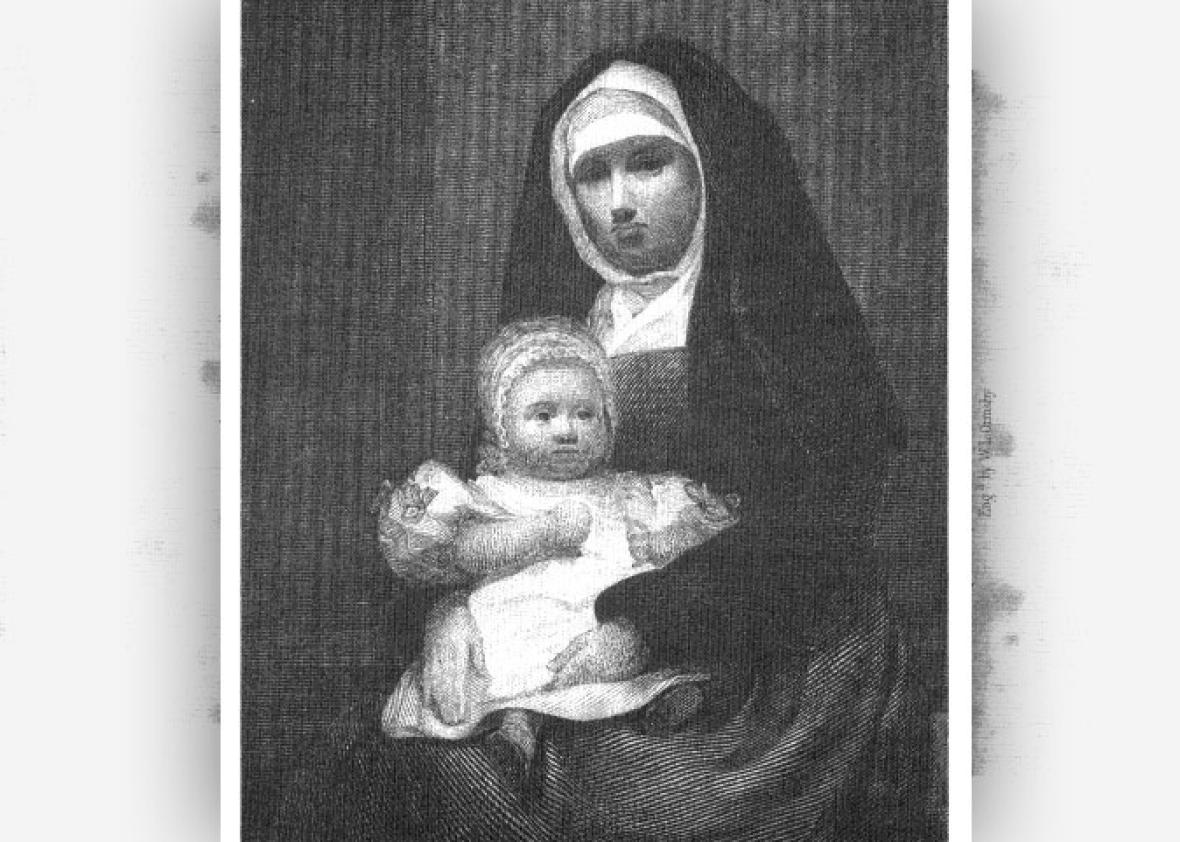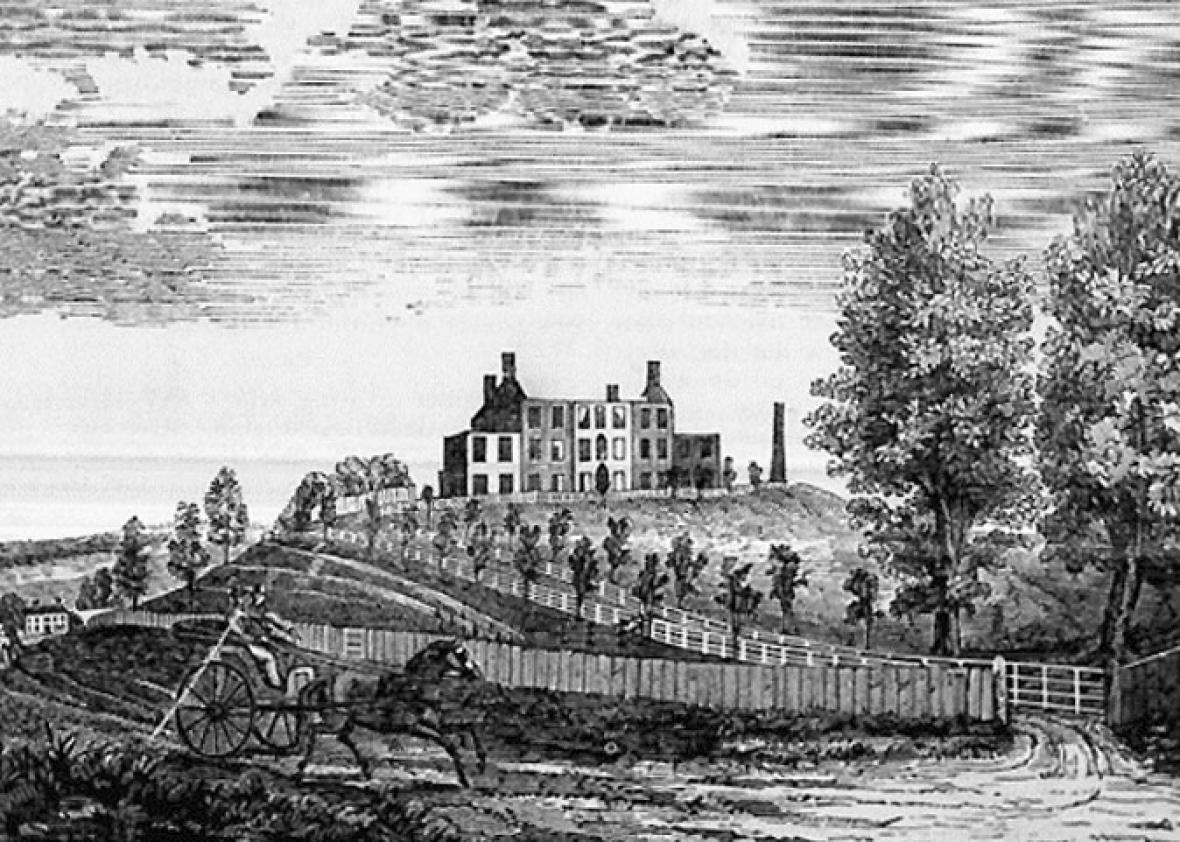Nativism, Violence, and the Origins of the Paranoid Style
By Mike Mariani
In 1826, the bishop of the Boston diocese, Jean-Louis Lefebvre de Cheverus, approved the construction of the Ursuline Convent school on a 24-acre property on a hilltop overlooking Boston Harbor. With financing from wealthy Boston families enthusiastic about the prospect of giving their daughters a private education to rival those of affluent boys, a lavish three-story brick house was built on a sprawling estate. But late into the night on Aug. 11, 1834, spurred by rumors that a nun named Elizabeth Harrison was being held at Ursuline against her will, an angry mob of Protestant men laid siege to the school, setting it ablaze with tar barrels. As the school burned to the ground, the nuns and students absconded out a back entrance. The United States in the 1830s was a time of nativism and deepening anti-Catholic resentment. The country was experiencing a massive influx of Irish immigrants, almost all of whom were Catholic. Protestants in New England and New York became wary, even paranoid, of the threat of the country tipping toward the Roman Catholic Church. Puritanism was one of the driving forces behind the American Revolution just a few decades prior, and Protestants cherished and would aggressively defend its independence from Rome. The idea that “popery” might be seeping into the states, taking a multitude of insidious forms, was a cause for alarm. Incipient nationalist movements took advantage of this widespread fear, disseminating conspiracy theories suggesting that the Irish were smuggling in a “foreign Catholic menace” that would not only usurp Protestantism but eventually topple American democracy. It was this wave of anti-Catholic bigotry that made something as heinous as the Ursuline school burning possible, as Protestant newspapers and demagogues preyed on people’s suspicions that parochial schools were run by the Vatican. Everyone involved in the convent burning was eventually acquitted of wrongdoing, further underscoring the grip of anti-Catholic sentiment. This nativist fury made Americans vulnerable to all manner of far-flung conspiracy theories and fantasist propaganda, and produced the ideal atmosphere for perhaps the most bizarre, lurid episode in the history of American agitprop: the publication of The Awful Disclosures of Maria Monk, the alleged autobiography of a young woman who claimed to have lived in a convent in Montreal rife with rape, torture, and systematic infanticide. The Awful Disclosures of Maria Monk was published in January 1836 into a media landscape that was already scorched by partisan religious warfare. Protestant newspapers like the American Protestant Vindicator and the unsubtly titled Downfall of Babylon, many based in New York, practiced yellow journalism with shameless aplomb, churning out copy that played to their readership’s xenophobic hysteria. Newspaper logos included a skull and crossbones with a papal hat and an image of churches collapsing into ruin. A cottage industry of literature—plays, pamphlets, sermons, even children’s books—stoked fear and conspiratorial thinking toward the Catholic Church. Ministers like Lyman Beecher delivered anti-Catholic speeches and published tracts outlining nativist ideologies. American Protestants felt threatened, economically and culturally, and their pervasive fear found its most sinister, unhinged form in depictions of Catholic nunneries. Demand for exposes increased after the success of Rebecca Reed’s Six Months in a Convent, another supposed autobiography published a year before Monk’s detailing a brutal system of forced indoctrination at the Ursuline Convent. (Although it wasn’t published until 1835, the manuscript of Reed’s work was passed around Protestant circles the year before its release, and some have speculated that it contributed to the Ursuline school burning.)
In The Awful Disclosures, Monk recounts her youth first as a student at the Congregational Nunnery, and later as a novitiate and nun at the Hotel-Dieu convent in Montreal, which she refers to in her memoir as the “Black Nunnery.” As soon as she takes the veil, the horrors begin: The Mother Superior at the convent tells her that among her duties as an initiated nun is an obligation to have “criminal intercourse” with priests in the neighboring seminaries. Two pages later, she’s told something ghastlier: Any infants born from these forced liaisons were hastily baptized, then strangled and thrown in a lime pit in the cellar underneath the convent. In the book’s climactic chapters, Monk herself becomes pregnant by a priest, and to spare her child a grisly fate, plots her escape. The book’s final moments are breathless, if suspiciously flimsy—it isn’t until the very last sentence that Monk unbars “the great gate” and is freed. Before her escape, Monk must bear witness to various intricacies of the convent’s clandestine practices. She stumbles upon jolting flashes of horror around every corner. She sees a young orphan girl being gagged. Like nocturnal vipers, lascivious priests make hissing sounds in the middle of the night to alert nuns and gain entry. Sisters are left to rot in dungeon prison cells. One particular young woman is murdered in a fashion best described as satanic play: Her executioners throw a mattress on top of her and stomp her to death. Each chapter or two offers some new perversity, a peep show whose cost is getting through Monk’s otherwise insipid prose. The Awful Disclosures was an immediate sensation, selling 20,000 copies in its first few months. (It went on to sell 300,000 by 1860.) In his famous 1964 essay “The Paranoid Style in American Politics,” Richard Hofstadter called it “probably the most widely read contemporary book in the United States before Uncle Tom’s Cabin.” Monk’s “autobiography” was a prototype of what is now known as the runaway nun narrative. In these stories, invariably framed as nonfiction accounts, a young girl takes the veil in a Catholic convent only to quickly discover she’s trapped herself in what essentially operators as a coercive cult, with little chance of escape. As Susan B. Griffin notes in her journal article “Awful Disclosures: Women’s Evidence in the Escaped Nun’s Tale,” these “convent exposes” are actually drawing on several long-standing genres in Western literature, including the Gothic novel, which featured dark secrets coiled inside old castles and manors, and the captivity narrative. Monk’s story is peppered with supernatural details, talk of evil spirits and unaccountable noises, and even an extremely old nun who may or may not rapture herself to heaven daily. Monk’s book was also constructed to interlock perfectly with her real-life circumstances: By the time the book was published, she was living in New York City with an illegitimate child in tow. Instead of being shunned or ostracized, as was, regrettably, the norm for unmarried mothers at the time, she stood as living proof of her saga of woe. Monk’s book was a sensation as soon as it was published. Protestant newspapers, which excerpted Awful Disclosures and discussed it avidly, immediately proclaimed it a courageous glimpse into the depravities of convent life. Outraged Protestants demanded that the Hotel-Dieu be investigated, to which the Bishop of Montreal, left with little choice in the face of such mounting pressure, eventually agreed. No evidence of any of the alleged crimes was turned up. Undaunted, anti-Catholic organizations like the New York Protestant Association accused the bishop of a cover-up, and offered to inspect the Hotel-Dieu themselves. With public furor escalating and many eager to see Monk’s extreme claims corroborated, W.F. Curry and G.W. Perkins, both widely respected Protestant clergymen, were chosen to conduct a second investigation into the Hotel-Dieu. They, too, turned up nothing. They also came away from the convent convinced that, given the huge discrepancies between Monk’s descriptions of the convent and their inspection of it, Monk herself had never set foot there. Still, Protestant publications and anti-Catholic organizations defended her vigorously, accusing the Protestant ministers of being Jesuits in disguise, and Catholic carpenters and masons of reconstructing the convent to discredit Monk’s story. The cracks, however, were beginning to spread. Sometime after the publication of The Awful Disclosures, Monk’s mother testified that the only connection her daughter ever had with the Catholic Church was the time she spent in Montreal’s Magdalene Asylum for wayward girls, which happened to coincide with her alleged stay at the convent. Another scandalous disclosure soon followed: Monk had traveled from Quebec to New York City with William Hoyt, head of the Canadian Benevolent Society and a known anti-Catholic agitator, and he had recruited several other Protestant ministers to help him write Monk’s story. The veracity of Monk’s narrative was further discredited when Hoyt and several other men sued each other over the rights to the book’s profits, all but publicly declaring the work their own collective fabrication. Even after major publications, editors, and other “authoritative” institutions and figures declared Monk’s expose a hoax, the book continued to enjoy widespread popularity. The idea that one’s political and cultural enemies were secretly partaking in such contemptible acts, including luring young Protestant girls into secret “priests’ brothels,” as Griffin calls them, was too salacious too resist. As Hofstadter put it, “Anti-Catholicism has always been the pornography of the Puritan... the anti-Catholics invented an immense lore about libertine priests, the confessional as an opportunity for seduction, licentious convents and monasteries.” Hofstadter’s essay presents several examples throughout American history of the titular “paranoid style” in American political thinking, particularly among right-wing groups that feel threatened or disenfranchised. These groups, he argued, prey on perceived dispossession, the feeling that, as he puts it, “old American virtues have already been eaten away.” Figures like Maria Monk, her Protestant handlers, and the fiery anti-Catholic demagogues of the 1830s and ’40s, whip up this paranoid thinking. The paranoia, in turn, feeds propaganda—the speeches, pamphlets, and news coverage masquerading as evidence confirming the paranoia. It’s an insidious cycle. First, the maelstrom of lies and disinformation begins to compete with facts and truth, successfully convincing people of a distorted reality based on prejudice fantasies. Second, a political movement born out of this paranoid style often transcends the fray, achieving a permanent seat at the table. It’s at this juncture that the true purpose of conspiratorial thinking reveals itself: It’s a way to smuggle a xenophobic agenda into mainstream politics under the appearance of legitimate fears and grievances. The anti-Catholic Protestant ministers and their organizations may not have truly believed that the pope was secretly conspiring to infiltrate America, brainwash its children, and despoil Protestantism, but they did fear a more diverse culture that included Irish Catholics. Their aim was unambiguously nativist: Demonize foreigners, stanch immigration, and preserve a homogenous society. Monk’s autobiography and its machinations serve as a remarkable example of how easily Americans are spellbound by a dazzling charlatan. But they’re also, more crucially, a testament to how today’s nasty sandstorms of lies and propaganda have all appeared before, under all-too-similar circumstances. The Awful Disclosures of Maria Monk was the fake news of the 1830s, a garish package of lies presented to the public as truth for the purpose of swaying political views. And it was largely successful. The anti-immigrant zeal of the 1830s laid the groundwork for the Native American Party of the 1840s (the irony lost on its members), a political party whose stated aim was to “purify” American politics by disenfranchising anyone not born in the United States. Sensationalist claims about Mexican rapists, New Jersey Muslims celebrating 9/11, inner city “carnage,” and secret global cabals use the same tactics to stoke prejudice through paranoia. Conspiratorial bigotry is hardly a novel approach to whipping up crowds, winning votes, and rupturing politics as usual. As the Ursuline school demonstrates, though, the rhetorical strategy almost always tips over into physical violence. Underneath the racist language and scapegoating lies a justification for brutality.
|
.
Any original material on these pages is copyright © BishopAccountability.org 2004. Reproduce freely with attribution.

